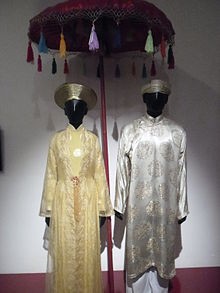(VOVworld) - The Vietnamese community has 54 ethnic groups. One of these - the Viet or the Kinh people - account for 90% of Vietnam’s total population. The Viet people live throughout the country, but are concentrated in the river deltas and urban areas. The Vietnamese language belongs to the Viet-Muong language group. On today’s first edition of “Colorful Vietnam-Vietnam’s 54 ethnic groups”, VOV reporter Lan Anh looks at the basic characteristics of the Viet people.
For centuries, ethnic groups in Vietnam have been bound to each other during the struggles against foreign invaders, a fight for national independence, and efforts to build a nation. Each group has their own language, literature and cultural identities reflected in community and economic activities. But the groups share similarities in clothing, food, social relations, wedding and funeral rites, worship, arts, and entertainment. Doctor Bùi Xuân Đính of the Vietnam Academy of Social Sciences says that to understand an ethnic group, the first thing to know is its origin. He said: “According to historical documents, the Viet people were the Lac Viet group belonging to the Bách Viet bloc, which consisted of many ethnic groups. Archeological findings over the past 40 years show that the ancestors of the Viet people inhabited Vietnam a long time ago. The ancient Viet population created their consecutive cultures called Phùng Nguyên, Gò Mun, Đồng Đậu and Đông Sơn based on wet rice cultivation and handicrafts. The most distinctive craft was bronze casting typified by bronze drums".
The first living areas of the Viet people are midland and northern river delta. In the early 11th century, they began moving to the central region and reclaimed land in the southern region. The Viet people also settled in the northeast, northwest and central highlands. They quickly adapted to the new environments and integrated into the lives of the indigenous ethnic groups. The Viet people, with their higher level of development, has helped boost the local economy. Doctor Đính said: “The Viet people used to be a unified bloc. But during the process of relocation, they had to adapt to local environments to survive. They created a new culture, absorbing the indigenous culture. The topography of the northeast region is different from the delta. So the Viet people had to use the agricultural methods and tools of the indigenous ethnic groups, such as growing rice in the valleys. Crop seasons were different as well.”
 |
| Costumes of Viet women (Source: vov.vn) |
 |
| Viet clothing (Source: Wikipedia) |
The Viet people lived mainly from agricultural production, including wet rice cultivation. Their farming was based on the lunar calendar and placed emphasis on crop seasons. Compared with other ethnic groups, the Viet people’s farming reached a higher level of productivity. They were also engaged in animal husbandry but on a small household scale. In line with social development, animal husbandry expanded to become a major activity. Handicraft among the Viet people flourished in the areas of food processing, weaving, knitting, pottery making and blacksmithing.
That has been a brief account of the Viet people, the majority ethnic group of Vietnam. On our next edition next Monday, we ‘ll tell you about the wet rice cultivation of the Viet people.